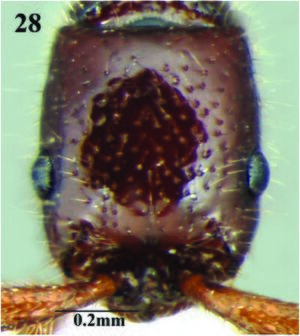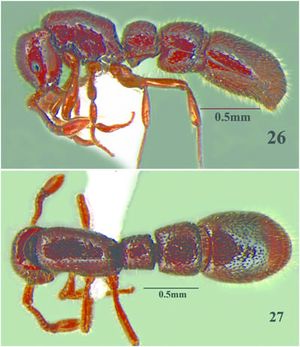Parasyscia schoedli
| Parasyscia schoedli | |
|---|---|

| |
| Scientific classification | |
| Kingdom: | Animalia |
| Phylum: | Arthropoda |
| Class: | Insecta |
| Order: | Hymenoptera |
| Family: | Formicidae |
| Subfamily: | Dorylinae |
| Genus: | Parasyscia |
| Species: | P. schoedli |
| Binomial name | |
| Parasyscia schoedli (Bharti & Akbar, 2013) | |
This species seems to be common in the Western Ghats; it was collected in non-forest as well as forest habitats in leaf litter and on dry soil surfaces.
| At a Glance | • Ergatoid queen |
Identification
Bharti & Akbar (2013) - This species is aberrant in many characters, with the cephalic dorsum bearing small punctures with average diameter lesser than the average distance separating them, a highly shinning body and reduced body sculpture, which separates it from other reported Indian species. C. schoedli shares most characters with Parasyscia seema, from which it can be easily distinguished by the combination of characters given in the diagnosis of the latter species. The new species can also be compared with Parasyscia luteoviger Brown, 1975 which also has small punctures on the cephalic dorsum, with diameter lesser than the average distance separating them. However, the peculiar petiolar node (with anterodorsal border concavely emarginate) and rounded head shape of C. luteoviger easily separates it from C. schoedli, which has the petiolar node broader than long and the posterior lateral corners of the head acute.
Keys including this Species
Distribution
Latitudinal Distribution Pattern
Latitudinal Range: 11.08333333° to 9.583333333°.
| North Temperate |
North Subtropical |
Tropical | South Subtropical |
South Temperate |
- Source: AntMaps
Distribution based on Regional Taxon Lists
Oriental Region: India (type locality).
Distribution based on AntMaps
Distribution based on AntWeb specimens
Check data from AntWeb
Countries Occupied
| Number of countries occupied by this species based on AntWiki Regional Taxon Lists. In general, fewer countries occupied indicates a narrower range, while more countries indicates a more widespread species. |

|
Estimated Abundance
| Relative abundance based on number of AntMaps records per species (this species within the purple bar). Fewer records (to the left) indicates a less abundant/encountered species while more records (to the right) indicates more abundant/encountered species. |

|
Biology
Castes
Queen
 
| |
| . | |
Nomenclature
The following information is derived from Barry Bolton's Online Catalogue of the Ants of the World.
- schoedli. Cerapachys schoedli Bharti & Akbar, 2013a: 93, figs. 1, 3A, 6A, 8A, 23-28 (w. ergatoid q.) INDIA (Kerala).
- Type-material: holotype worker, 25 paratype workers, 3 paratype ergatoid queens.
- Type-locality: holotype India: Kerala, Silent Valley Nat. Park, 11°5’N, 76°26’E, 897 m., 25.ix.2011, Winkler (S.A. Akbar); paratypes: 13 workers, 3 ergatoid queens with same data, 2 workers Kerala, Salim Ali Bird Sanctuary, 10°45’N, 76°44’E, 118 m., 6.xi.2011, Winkler (S.A. Akbar), 10 workers Kerala, Periyar Tiger Reserve, Manalar, 9°35’N, 77°18’E, 1630 m., 27.x.2011, hand picking (S.A. Akbar).
- Type-depositories: PUAC (holotype); BMNH, PUAC (paratypes).
- Combination in Parasyscia: Borowiec, M.L. 2016: 205.
- Status as species: Bharti, Guénard, et al. 2016: 22.
- Distribution: India.
Type material. Holotype worker: India. Kerala, Silent valley national park, 11°5'N, 76°26'E, 897m a.s.l., 25.ix.2011, Winkler. Paratypes: 13 workers and 3 ergatoid queens, same data as holotype; 2 workers, India, Kerala, Salim Ali Bird Sanctuary, 10°45'N, 76°44'E, 118m a.s.l., 6.xi.2011, Winkler; 10 workers, India, Kerala, Periyar tiger reserve, Manalar, 9°35'N, 77°18'E, 1630m a.s.l., 27.x.2011, hand picking (coll. Shahid A. Akbar). Holotype in PUAC and paratype in BMNH. Unless otherwise noted the text for the remainder of this section is reported from the publication that includes the original description.
Description
Worker
Measurements (holotype in brackets): HL 0.64–0.68(0.68); HW 0.44–0.46(0.46); EL 0.07–0.11(0.11); WL 0.62–0.69(0.69); MH 0.41–0.48(0.48); PrW 0.31–0.35(0.35); PL1 0.24–0.27(0.27); PW1 0.28–0.31(0.31); IIIAL 0.28–0.32(0.32); IIIAW 0.39–0.41(0.41); SL 0.31–0.33 (0.33); IVAL 0.70–0.74(0.74); IVAW 0.58–0.60(0.60). Indices: CI 67–69 (67); SI 70–72(72); PI 114–116 (114) (n=11).
Head, rectangular, longer than broad; sides parallel; vertexal border transverse. Posterior lateral corners acute. Parafrontal ridges present, raised. Eyes medium sized, almost circular. Mandibles subtriangular; masticatory margins without a row of small denticles. Lateroclypeal teeth small. Antennae 12 segmented; scapes short, each falling short of posterior margin of head by 1/3rd of its length.
Mesosoma. Stout, humped in profile view; dorsal surface convex, continuous with sides, no lateral margins. Declivous face of propodeum with cariniform margins across the top and along the lateral margins.
Metasoma. Petiole broader than long, and gently rounded towards the sides. Anterior and posterior faces transverse. Subpetiolar process stout, fenestra present. Postpetiole almost rectangular, wider behind, with the posterolateral angles not tuberculate but uniformly rounded. Gaster elongate; base of cinctus of first gastral tergite with cross ribs; sting exerted.
Sculpture. Mandibles with small punctures. Head smooth and shining with some punctures. Mesosoma mostly smooth and shining with some punctures along the sides. Petiole, postpetiole and gaster with continuous punctures.
Vestiture. Body covered with moderate, decumbent or subdecumbent hairs, most prominent on gaster; apical funicular segments and legs also with standing hairs.
Colour. Bright yellowish orange to dark red.
Queen
Ergatoid. HL 0.80–0.84; HW 0.59–0.63; EL 0.14–0.16; WL 0.88–0.92; MH 0.51–0.55; PrW 0.49–0.53; SL 0.41–0.43; PL1 0.29–0.31; PW1 0.38–0.41; IIIAL 0.44–0.50; IIIAW 0.57–0.59; IVAL 0.88–0.90; IVAW 0.86–0.88. Indices: CI 73–75; SI 68–69; PI 131–132 (n=3).
Like the workers of the same colony, but larger, with more stout body, especially the mesosoma and gaster. Ocelli absent on vertex. Distinction between ergatoid queens and worker is vague, with size variation of workers very high.
Etymology
The species is named in the honor of the late Dr. Stefan Schödl.
References
- Borowiec, M.L. 2016. Generic revision of the ant subfamily Dorylinae (Hymenoptera, Formicidae). ZooKeys 608: 1-280 (doi: 10.3897/zookeys.608.9427).
- Aswaj, P., Sahanashree, R., Udayakantha, W.S., Aniruddha, M., Priyadarsanan, D.R. 2021. Two new species of doryline ants (Hymenoptera, Formicidae) with 11-segmented antennae from India. ZooKeys 1056, 59–72 (doi:10.3897/zookeys.1056.68722).
- Bharti H, Ali Akbar S. 2013b. Taxonomic studies on the ant genus Cerapachys Smith (Hymenoptera, Formicidae) from India. ZooKeys 336: 79–103. doi: 10.3897/zookeys.336.5719.
- Chen, Z., Liang, C., Du, C. 2022. Revision of Chinese species of the ant genus Parasyscia Emery, 1882 (Hymenoptera: Formicidae: Dorylinae). Zootaxa 5196(3), 301–330 (doi:10.11646/zootaxa.5196.3.1).
- Mizuno, R., Eguchi, K., Satria, R., Dang, A. V., Bui, V. T., Phung, L. T. H., Ito, F. 2023. Colony composition, phasic reproduction, caste dimorphism, and prey preferences of the oriental non-army doryline ant Yunodorylus eguchii (Borowiec, 2009) (Hymenoptera: Formicidae: Dorylinae). Insectes Sociaux 70(1), 105–117 (doi:10.1007/s00040-023-00898-4).
References based on Global Ant Biodiversity Informatics
- Dad J. M., S. A. Akbar, H. Bharti, and A. A. Wachkoo. 2019. Community structure and ant species diversity across select sites ofWestern Ghats, India. Acta Ecologica Sinica 39: 219–228.
